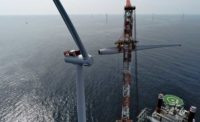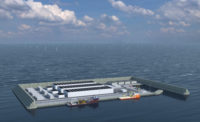The world's largest-capacity offshore wind energy project has gone live in the North Sea centered about 56 miles off the U.K.'s east coast. Developed by Denmark-based Ørsted A/S, the 1.3-GW Hornsea 2 project includes 165 wind turbines, each with 266-ft-long blades.
Hornsea 2, spread over 178 sq miles of sea and connected to shore via 242 miles of power cables, lies next to the existing 1.2-GW, 170-turbine Hornsea 1 farm, which began operating in June 2019. They are both adjacent to the planned 2.8-GW Hornsea 3 project, which secured a commercial contract for difference from the U.K. government earlier this year.
Ørsted operates 13 U.K. offshore wind farms totaling 6.2 GW, enough to power more than 7 million homes. "By 2030, we will be on track to power over a quarter of U.K. households," notes Darren Ramshaw, vice president and head of U.K. east coast region.
In July, installation also started of 277 monopile foundations for the vast Dogger Bank offshore wind project centered 81 miles off the U.K.'s east coast. More than 236 ft tall, each foundation weighs nearly 1,200 tons. The project is due for completion in three 1.2-GW phases between the second half of next year and 2026.
“The North Sea is uniquely positioned to help meet European objectives of reliable, affordable and sustainable energy supplies," according to Pål Eitrheim, executive vice president for renewables at the energy company Equinor. A joint venture of SSE Renewables (40%), Equinor (40%) and Eni Plenitude (20%) owns the project.
There were seven offshore wind projects under construction in the seas around Europe in first half of this year, including Hornsea 2, according to the trade body WindEurope. Projects off France, Germany, Italy, the Netherlands, Norway and the U.K. totaled 3.8 GW.




Post a comment to this article
Report Abusive Comment